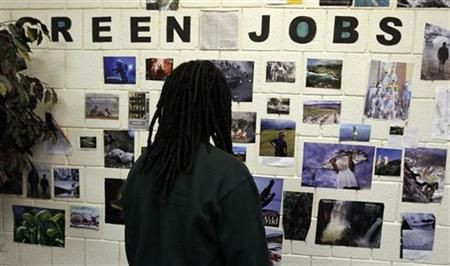Green Jobs Make Up One-Third of Construction Workforce: McGraw Hill

Green jobs are now an established part of the design and construction workforce and are only likely to grow ithis decade, according to a new study from McGraw-Hill Construction.
The study, released earlier this month during the Greenbuild International Conference and Expo in Toronto, Canada, found that 35 percent of architects, engineers and contractors -- representing about 661,000 jobs -- work in the renewable energy industry. That share is expected to rise over the next three years, with 45 percent of all design and construction jobs projected to be green by 2014.
Green jobs are already an important part of the construction labor workforce, and signs are that they will become industry standard, Harvey Bernstein, vice president, Industry Insights and Alliances for McGraw-Hill Construction, said in a statement.
Green Jobs: Capable of Adding Substantially to U.S. GDP
The study, the first to focus exclusively on design and construction professionals and trade workers, refutes the claims of many who insist that investing in green jobs will not improve the U.S. economy. The Wall Street Journal attacked government support of green job growth in an Oct. 11 editorial, claiming President Obama failed in his promise to create five million green jobs after initiating the New Energy for America plan in 2009.
The newspaper wrote that the administration's green jobs record is dismal and states that only 10 percent of the 53,000 workers who have been trained for renewable energy jobs under the plan have found employment.
However, those in support of the initiative point out that the New Energy for America Plan calls for investing $150 billion over a 10-year period to create those five million new jobs -- so far, only three years have passed. In addition, the policy also calls for passing an economy-wide cap and trade program and implementing a national renewable energy standard, in addition to the $15 billion yearly investment, all critical policies toward the plan's success that have not been passed by Congress.
While only 8,035 of the 53,000 who have been trained by the Department of Labor have reportedly found jobs, Green For All reports those figures only include workers who have already been fully trained, and not those who are currently undergoing training or those scheduled to enter training programs funded by Department of Labor grants. Moreover, the organization reports that most training did not begin until the last half of 2010 and said the statistic ignores incumbent worker training -- meaning, those participants who were already employed but were receiving additional training to increase their worth in the labor market. About 40 percent of those trained through the New Energy for America plan have been incumbent workers.
Still, even without those policies, green jobs are still expected to become more prevalent. The green building market represented 25 percent of all new U.S. construction activity in 2010; today, McGraw Hill reports that a third of all new nonresidential construction is green, a figure that is expected to triple by 2015.
Clean Energy Sector Data
Plus, a 2009 report from the Political Economy Research Institute at the University of Massachusetts, Amherst found that clean-energy investments generate more than three times as many jobs within the U.S. as fossil fuel investments. Green companies tend to spend more of their overall investment budget on hiring employees rather than acquiring machines, supply and land, according to the report, which also said clean-energy investment relies more on products made within the U.S. while creating jobs that have more opportunities for growth and advancement.
With zero hesitation, this is a business opportunity, said Rick Fedrizzi, President and CEO of the U.S. Green Building Council, told Climate Progress regarding the construction industry. I learned a while ago that we are not going backwards ever again. I don't care how much money popped up on the scene tomorrow, people will never go back to building inefficient buildings that deprive humans of daylight and superior health opportunities.
© Copyright IBTimes 2024. All rights reserved.





















